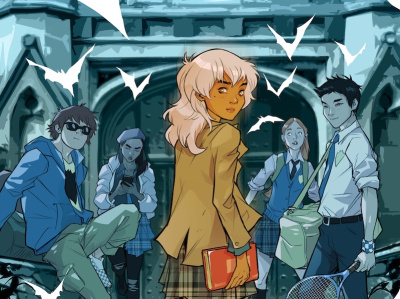We recently conducted our annual interview with Marvel publisher Dan Buckley about the state of the comics business and Marvel's place in it. In Part 4, we talk about whether Marvel would ever license its comics (like it does toy manufacturing), whether comic-based movies are a bubble, how Marvel is approaching the female young adult market, and the challenges and opportunities for the coming year.
We had a discussion on our site a couple of months back prompted by speculation that since Marvel had oriented its business much more toward being a licensing company in the last few years that you might take the same approach to comics and license out your properties to be published by other publishers. What's your response to that?
From a business theorem I can understand why it's discussed, but it's just not something Marvel would explore because this is where we create the properties. This is the core area where the heartbeat is. Movies are driving them through the roof, don't get me wrong, and when we get animation up and going, TV. But this is where things are created and played with and presented and come out. It's not something I would foresee happening...at all!
So the difference between comics and movies or videogames or toys is that comics are where the IP comes from.
Yeah, it's where we manage the IP.
In other words, those are the style guides.
For the most part. It allows us to play with the style guides a little bit too.
Comics and movies have become so intertwined in all directions. In San Diego you can see that connection at so many levels, on the floor, and in panels. What do you think about that phenomenon in potential for further growth? Are we maxed out, is it a bubble, are we ever going to hit a wall where as fast as over the last few years comics have become a key source of IP for Hollywood that changes and turns back away from comics?
I don't foresee that happening (I hate giving such a simple answer to this). Once we're making good movies, and it's coming from good source material, the source material is solid for those people to make good decisions on their own with their own properties. Is it going to be explosive growth continuously? I don't think so, but I still see some growth. Do I see a bubble bursting on it real soon? No. Because we're in year five for this, and it's Sin City, Fantastic Four, Batman. They've all done relatively well, if not really well! People might put different expectations on these products at certain levels, but they're delivering from a box office standpoint and we haven't even got into the DVD part of the world. And then you're looking at sequels, at least on our side, for X-Men and Spider-Man. And then you're going to be looking at DC opening up the chest with Superman. So I don't see it falling off the charts. And then you still have these really cool things sitting on the side like a Sin City, an American Splendor, a Ghost World. It's a rich place for IP development. I don't see the bubble bursting. Some of the properties and movies haven't done that well and some have done well, and it's gone through that OK over the last couple of years; that's why I don't see it as bursting.
Otherwise after a movie like Elektra, which was quite a bit under expectations, people would have thrown up their hands and said, 'This is over.'
Then you go back and look at FF and Sin City, two very different movies, and Batman, and they've all done well. You're going to have hits and misses; that happens in any genre. Especially when you see what's coming down the pipe, I don't see anything exploding in the future.
We asked your Distinguished Competition this in a recent interview, and we want to ask you also: you mentioned Runaways as one way you're reaching out to what we think is the fastest growing part of the comics market, teen girls. How can Marvel attract that audience or help it grow?
The most important thing we need to do right now is to develop product that works there. Runaways is a good example, Spellbinders, and Machine Teen are products that we definitely feel if you look at it you're going to realize that's what they're designed for. I know I'm missing one...Mary Jane... We need to develop some depth, a backlist, something where we can develop some presence. A year ago we didn't have anything that we could walk into anybody to develop any kind of presence. I think we have enough product now that we can go in and start talking to people about developing a presence where it's not just one-off books off to the left or to the right. And one of the richest categories for us to date is still X-Men, how we tap into that. So we just need to keep designing the product. Then the next step is talking to the retail outlets where we think that will work and developing the marketing plan. You can develop marketing and awareness for a product to say 'Come try this,' but if we don't have the right product design for them to pick up it isn't going to go very far.
I know we can't impersonate manga. That's not going to be the answer to this question. Because manga's manga. Marvel makes Marvel books. We can play with the storytelling a little bit, but those girls that are reading manga have a very definitive understanding of what they feel manga is. I think it's something between manga and chapter books. We need to keep on playing with the product (and now I think we have enough to develop a presence), and now we just have to communicate directly with the end user and promote it and work with the distribution sources for it. We definitely need to work very closely with the bookstores to make that work.
Where do you see the key challenges and opportunities for Marvel over the next twelve months in growing the market?
Continued support firming up the newsstand business. Continually trying to develop that product that can catch some buzz with the YA female market. Runaways is a good example. I know it's not huge but it's a step in the right direction. Runaways made the Top Ten for Teen People's Buzz List. We never had anything there (laughs). So that's big news for us, and we just need to continue to build on that success. For our core business, for the direct market, we need to try to continue to put the best creators working with our best characters and get some really cool stories and deliver them on time so our biggest partners, the direct market retailers, have something to provide to their core and the new readers who come in. So [to summarize], continued support and growth in newsstand--just make sure it sticks; developing product with the book markets for YA market and market expansion (and not just for the YA market, but something that can reach out farther to the masses and expose people to graphic fiction); and for the direct market, just develop the best creators and the best characters.
Our interview with Dan Buckley is an annual event. For last year's interview, see Interview with Marvel Publisher Dan Buckley, Part 1, and Interview with Marvel Publisher Dan Buckley, Part 2







